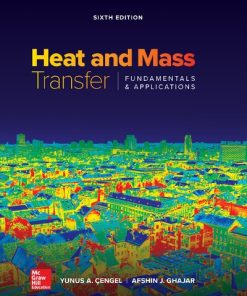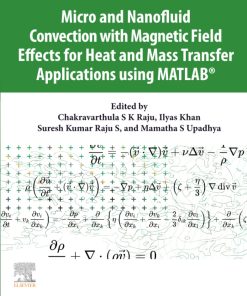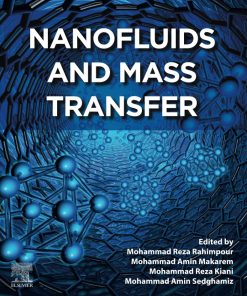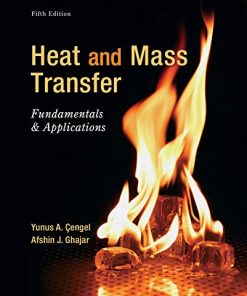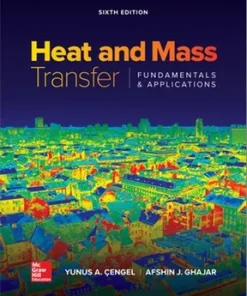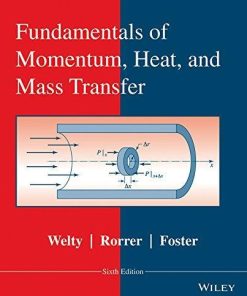Nanofluids for Heat and Mass Transfer Fundamentals Sustainable Manufacturing and Applications 1st edition by Bharat Bhanvase 0128219475 9780128219478
$50.00 Original price was: $50.00.$25.00Current price is: $25.00.
Nanofluids for Heat and Mass Transfer Fundamentals, Sustainable Manufacturing and Applications 1st edition by Bharat Bhanvase – Ebook PDF Instant Download/DeliveryISBN: 0128219475, 9780128219478
Full download Nanofluids for Heat and Mass Transfer Fundamentals, Sustainable Manufacturing and Applications 1st edition after payment.
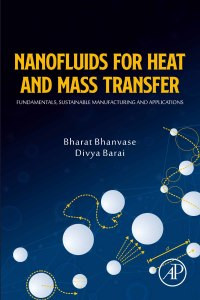
Product details:
ISBN-10 : 0128219475
ISBN-13 : 9780128219478
Author : Bharat Bhanvase
Nanofluids for Heat and Mass Transfer: Fundamentals, Sustainable Manufacturing and Applications presents the latest on the performance of nanofluids in heat transfer systems. Dr. Bharat Bhanvase investigates characterization techniques and the various properties of nanofluids to analyze their efficiency and abilities in a variety of settings. The book moves through a presentation of the fundamentals of synthesis and nanofluid characterization to various properties and applications. Aimed at academics and researchers focused on heat transfer in energy and engineering disciplines, this book considers sustainable manufacturing processes within newer energy harvesting technologies to serve as an authoritative and well-rounded reference.
Nanofluids for Heat and Mass Transfer Fundamentals, Sustainable Manufacturing and Applications 1st Table of contents:
Section A: Introduction to nanofluids: Fundamentals and synthesis
1: Introduction to nanofluids
Abstract
1.1: Introduction
1.2: Colloids and nanofluids
1.3: Scope
1.4: Classification of nanofluids
1.5: Commercial nanofluids
2: Laboratory-scale synthesis and scale-up challenges
Abstract
2.1: Introduction
2.2: Laboratory-scale synthesis methods for nanofluids
2.3: Performance evaluation systems and their reliability
2.4: Large-scale production of nanofluids
2.5: Scale-up challenges and cost estimations
2.6: Problems
3: Stability of nanofluids
Abstract
3.1: Importance and mechanism of stability of nanofluids
3.2: Theoretical aspects
3.3: Dispersion techniques for nanofluids
3.4: Enhancement of stability of nanofluids and factors affecting
3.5: Evaluation of stability
Section B: Properties of nanofluids: Fundamentals and methods
4: Thermophysical properties of nanofluids
Abstract
4.1: Introduction
4.2: Thermal conductivity: Principle, mechanism, and measurement
4.3: Rheological properties: Mechanism and types of rheological behaviors of nanofluids
4.4: Specific heat: Mechanism and measurement techniques
4.5: Density: Mechanism and measurement techniques
4.6: Surface tension: Mechanism and measurement techniques
4.7: Problems
5: Electrical, optical, and tribological properties of the nanofluids
Abstract
5.1: Introduction
5.2: Measurement techniques
5.3: Factors affecting electrical conductivity of nanofluids
5.4: Factors affecting optical properties of nanofluids
5.5: Factors affecting tribological properties of nanofluids
5.6: Theoretical models of electrical conductivity of nanofluids
5.7: Theoretical models of optical properties of nanofluids
Section C: Theoretical aspects of nanofluids
6: Physical models for computational studies
Abstract
6.1: Introduction
6.2: Single-phase approaches
6.3: Two-phase approaches
6.4: Lattice-Boltzmann method
7: Computational studies on nanofluid-based systems
Abstract
7.1: Introduction
7.2: Computational fluid dynamics for nanofluid simulation
7.3: 3D modeling for computational study of nanofluids
7.4: CFD software for nanofluid studies
8: Actual vs theoretical behavior of nanofluids
Abstract
8.1: Introduction
8.2: Evaluation of actual vs theoretical behavior of nanofluids
Section D: Heat and mass transfer using nanofluids: Fundamentals, applications, and challenges
9: Heat transfer using nanofluids
Abstract
9.1: Introduction
9.2: Measurement of heat transfer coefficient in nanofluid systems
9.3: Convective heat transfer
9.4: Boiling heat transfer and factors involved
9.5: Evaporation and condensation and factors involved
9.6: Theoretical models for Nusselt number of nanofluids
9.7: Pressure drop and friction factor in nanofluid flow and their theoretical models
10: Heat transfer applications of nanofluids
Abstract
10.1: Introduction
10.2: Heating, cooling, and thermal management systems
10.3: Refrigeration systems
10.4: Solar thermal systems
10.5: Extraction of energy sources
10.6: Nuclear reactors
11: Mass transfer applications of nanofluids
Abstract
11.1: Introduction
11.2: Theoretical background of mass transfer in nanofluids
11.3: Mechanism of mass transfer in nanofluids
11.4: Separation processes
11.5: Catalysis
11.6: Phase change materials
12: Other applications of nanofluids
Abstract
12.1: Introduction
12.2: Tribological applications
12.3: Antibacterial applications
12.4: Medical applications
12.5: Sensing applications
13: Future possible applications and challenges in using nanofluids
Abstract
13.1: Introduction
13.2: Future possible applications of nanofluids
13.3: Gaps in research
13.4: Challenges in using nanofluids
13.5: Health, safety, and environmental concerns
People also search for Nanofluids for Heat and Mass Transfer Fundamentals, Sustainable Manufacturing and Applications 1st:
nanofluids for heat and mass transfer
heat transfer in nanofluids-a review
fundamentals of heat and mass transfer solutions
fundamentals of heat and mass transfer solutions pdf
heat and mass transfer fundamentals and applications 6th edition
Tags: Nanofluids, Heat, Mass Transfer Fundamentals, Sustainable Manufacturing, Applications, Bharat Bhanvase
You may also like…
Engineering - Chemical Engineering
Heat and Mass Transfer for Chemical Engineers: Principles and Applications 1st Edition
Engineering
Mathematics - Mathematical Physics Technique - Nanotechnology
Technique - Nanotechnology




